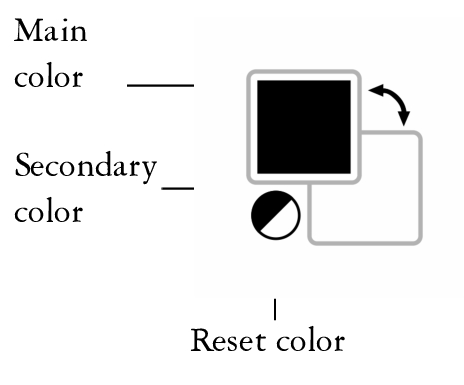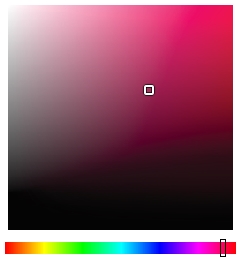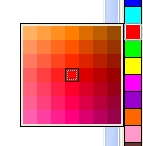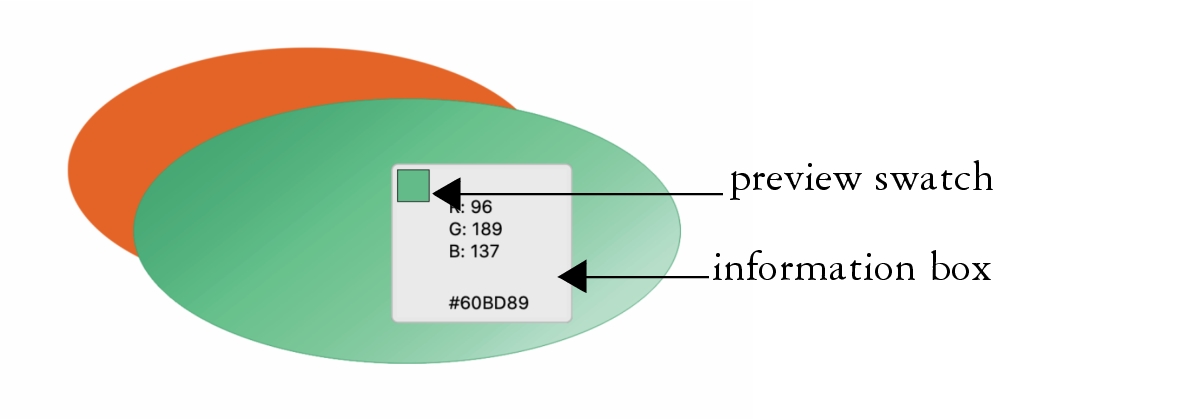Choose colors
You can choose main and secondary colors by selecting a color from the color control area, color palettes, color viewers, color harmonies, or color blends and by sampling colors from an image.
For information about applying the colors you choose, see Uniform fills, Draw and paint, and Work with objects.
In the color control area, you can view the selected main and secondary colors, and you can choose new colors. The main color applies to all the paint tools, and to the color of text when it is first typed. The secondary color is shown when you erase background areas with the Eraser tool.
A color palette is a collection of color swatches. In some programs, color palettes are known as "swatch palettes."
In Corel PHOTO-PAINT, the default color palette is based on the color mode of the image. For example, if you open a CMYK image, a CMYK palette appears in the image window, if you open a paletted image, an RGB palette appears in the image window.
You can choose main, secondary, and fill colors by using the default color palette, which contains colors from the RGB color model.
When you create a new image, the application automatically generates an empty palette, called the Image palette. It helps you keep track of the colors that you use by storing them for future use. For more information, see Image palette.
Palette libraries and custom color palettes
The color palettes that are found in the Palette libraries cannot be edited directly. Some of them are provided by third-party manufacturers, for example PANTONE, HKS Colors, and TRUMATCH. It may be useful to have on hand a manufacturer’s swatch book, which is a collection of color samples that shows exactly what each color looks like when printed.
Some palettes found in the Palette libraries — PANTONE, HKS Colors, TOYO, DIC, Focoltone, and SpectraMaster — are collections of spot colors. If you create color separations when you print, each spot color requires a separate printing plate, which can significantly affect the cost of the printing job. If you want to use color separations but would like to avoid using spot colors, you can convert the spot colors to process colors when printing. For more information, see Color separations.
Custom color palettes can include colors from any color model, including palettes found in the Palette libraries, such as a spot color palette. You can save a custom color palette for future use. For more information about working with custom color palettes, see Create and edit color palettes.
When you want to use a color that already exists in an object or image, you can sample the color to achieve an exact match. By default, you sample a single pixel from the image window.
When you sample a color from a photo, what looks to be a solid-colored area may actually be subtly shaded or dithered. In this case, it is useful to average the colors of pixels in a larger sample area. You can set the sample area to 3 × 3 pixels, or to 5 × 5 pixels for high-resolution images. You can also sample pixels in a selected area.
If you want to sample and use numerous colors from the image window, you can store them on a custom color palette. For more information on custom color palettes, see Create and edit color palettes.
Color viewers provide a representation of a range of colors by using either one-dimensional or three-dimensional shapes. The default color viewer is based on the HSB color model, but you can use this viewer to choose CMYK, CMY, or RGB colors. For information about color models, see Color models.
You can use web colors when you design documents that will be published to the web. With Corel PHOTO-PAINT, you can define web colors by using RGB hexadecimal values (for example, #aa003f).
If you choose a color that is outside of the printer gamut, Corel PHOTO-PAINT allows you to replace it with a similar color that is in the printer’s gamut.
To choose a color by using the color control area
You can also choose main and secondary colors by using the Color docker. To open the Color docker, click Window ![]() Dockers
Dockers ![]() Color.
Color.
To choose a color by using the default color palette
You can display color names by pointing to a swatch.
You can also choose main and secondary colors by using the Color docker. To open the Color docker, click Window ![]() Dockers
Dockers ![]() Color.
Color.
An example of a pop-up color palette
To choose a color by using a color palette
Each spot color swatch on a color palette is marked with a small white square.
If you choose a color that is outside of the printer gamut, Corel PHOTO-PAINT allows you to replace it with a similar color that is in the printer’s gamut. For more information, see To replace an out-of-gamut color with a reproducible color. For information about color correction, see Color management.
You should use the same color model for all colors in an image; the colors will be consistent, and you will be able to predict the colors of the final output more accurately. For more information about reproducing colors accurately, see Color management.
You can also access color palettes in the Color docker by clicking the Show color palettes button, and choosing a palette from the list box. If the Color docker is not open, click Window
![]() Dockers
Dockers ![]() Color.
Color.
To sample a color
In the image window, a preview swatch is attached to the Eyedropper tool, along with an information box listing the color model component values. When you sample an RGB color, the information box also includes the hexadecimal color value.
You can also activate the Eyedropper tool by pressing the O key. Click the Spacebar to return to the previously selected tool.
You can also use the Image info docker to view the color model component values for an image pixel, such as the red, green, and blue components of a pixel in an RGB image or its hexadecimal color value. If the Image info docker is not open, click Window ![]() Dockers
Dockers ![]() Info.
Info.
To choose a fill color by using a color viewer
If you choose a color that is outside of the printer gamut, Corel PHOTO-PAINT allows you to replace it with a similar color that is in the printer’s gamut. For more information, see To replace an out-of-gamut color with a reproducible color. For information about color correction, see Color management.
You should use the same color model for all colors in an image; the colors will be consistent and you will be able to predict the colors of the final output more accurately.It is preferable to use the same color model in your drawing that you will be using for the final output.
You can choose a fill color by double-clicking the Main color swatch in the color control area. Click the Uniform fill button
in the Select fill dialog box, and click Edit.
You can swap the Old color (the current main or secondary color) and the New color (which has been chosen in the color selection area) by clicking Options ![]() Swap colors.
Swap colors.
You can also access color models in the Color docker by clicking the Show color viewers button and choosing a color model from the list box. If the Color docker is not open, click Window
![]() Dockers
Dockers ![]() Color.
Color.
To choose a web color
You can specify hexadecimal color values only when working with RGB colors.
If you type an invalid hexadecimal value, the color does not change.
You can view hexadecimal color values on the status bar.
You can also choose web colors from the Main color, Secondary color, or Uniform fill dialog boxes. These dialog boxes also let you view and copy the hexadecimal equivalents of non-RGB colors.




